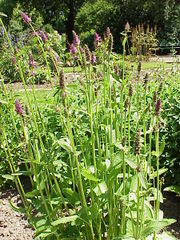Stachys affinis
| Stachys affinis subsp. var. | Chinese artichoke | |||||||||||||||||||||||||||||||||||||||||||||||||||||||
|---|---|---|---|---|---|---|---|---|---|---|---|---|---|---|---|---|---|---|---|---|---|---|---|---|---|---|---|---|---|---|---|---|---|---|---|---|---|---|---|---|---|---|---|---|---|---|---|---|---|---|---|---|---|---|---|---|

|
|
| ||||||||||||||||||||||||||||||||||||||||||||||||||||||
| ||||||||||||||||||||||||||||||||||||||||||||||||||||||||
Stachys affinis, the Chinese artichoke, chorogi, knotroot, artichoke betony, or crosne, is an herbaceous perennial plant of the family Lamiaceae. Although its edible tuber can be grown as a root vegetable, it is a rare sight in the garden. From a cultivation standpoint this is rather odd — the plant is easy to grow, requiring neither staking nor earthing-up. The reason that it is so unpopular is the nature of the tubers — small, convoluted and indented, so that it is the cook rather than the gardener or the family who finds this vegetable frustrating. The thin skin is of whitish-brown or ivory-white. The flesh underneath, under proper cultivation, is white and tender. It is in season generally commencing with October.
The flavor of the tubers is delicate and delicious — they can be treated as Jerusalem artichokes in cooking. It is used as a vegetable, in salad compositions, but more so as a garnish. It has a nutty, artichoke-like flavor.
Cultivation
Propagation
Pests and diseases
Varieties
Gallery
-
photo 1
-
photo 2
-
photo 3
References
External links
- w:Stachys affinis. Some of the material on this page may be from Wikipedia, under the Creative Commons license.
- Stachys affinis QR Code (Size 50, 100, 200, 500)
